Quake III Revolution Hands-On
The PC game that started a phenomenon is back again in its latest incarnation, and it's finally making its way to the PS2. We had the chance to sit down with a near-final version of the game to see just what UK-based developer Bullfrog is doing with the series.
The PC game that started a phenomenon is back again in its latest incarnation, and it's finally making its way to the PS2. Quake III Revolution will include more improvements on id Software's acclaimed first-person shooter than any other version, with new maps, enhanced player models and environments, and brand-new play modes. We had the chance to sit down with a near-final version of the game to see just what UK-based developer Bullfrog is doing with the series.
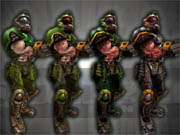
Quake III Revolution promises to play like no other version of Quake III. There are certain problems inherent in creating a new version of the game, which was largely dependent on Internet multiplayer play, for a console without Internet connectivity. Bullfrog is dealing with these problems by focusing on Quake III's single-player elements, and it's working on creating a version of Quake III that is more story-driven and caters more to the single player. The result is Quake III Revolution, a game that takes all the best elements from the Quake III games and squeezes them into a purely single-player experience.
The biggest change to the gameplay of the PC and DC versions of Quake III is the addition of the single-player campaign mode. The campaign mode takes you from a rookie combatant to the top of the ranks, and it's set up similarly to Unreal Tournament's campaign mode. At the start of the campaign mode, you pick one of five characters--Sarge, Anarki, Daemia, Doom, or Klesk. Each character has five vital stats--attack power, speed, health, and armor--and each of the five characters has different strengths and weaknesses. For example, Anarki is fast but not that powerful, Klesk is powerful but not that fast, and Sarge is only average in each category. As you progress through the campaign mode, your character will become a better, more hardened warrior and will receive upgrades to his or her stats. Additionally, as you become more seasoned, your character's appearance will actually start to change to reflect his or her battle experience. These changes range from scorched battle armor or more prominent veins in the character's skin mass to cybernetic implants that are visible on the character's face.
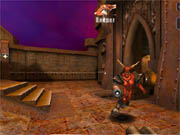
The campaign mode is a series of battles that have different objectives and parameters. The campaign mode has eight different battle types, each of which is a variant of one of three basic game objectives: deathmatch, flag, and elimination. The deathmatch modes are fairly simple--kill a set number of other players before the time limit expires. The basic variants are kill vs. time, where the frag and time limit are the same number; single-weapon deathmatch, where you can only use one randomly selected weapon; and team deathmatch, where two opposing sides fight a team battle. The flag modes involve taking possession of a flag and either transporting it to your base or simply holding it for a set time limit. The elimination mode works similarly to a tournament mode--you fight a series of opponents with only a few lives to spare before you lose. After you eliminate one opponent, you're transported to a different part of the map to fight the next player. As you progress through the campaign mode, you'll be awarded various power-ups, medals, and stat increases depending on your performance.
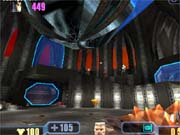
Quake III Revolution also has multiplayer versions of almost all the modes found in the campaign game, and it supports up to four players in the multiplayer quad-screen mode. You'll be able to import your characters from the saved campaign game and play against friends in the multiplayer modes, which include deathmatch, single-weapon deathmatch, single-weapon team deathmatch, capture the flag, team deathmatch, possession, and kill vs. time. You'll be able to select from any of the standard QIII maps, and you can even populate maps with computer-controlled bot players. The PS2 version of the game features the same bot AI interface as the PC version--each bot not only has a favorite weapon, but it also employs a particular style of play. This lets you simulate a wide range of human players and customize exactly what sort of computer-controlled opponents you'd like to play against. As the game no longer features Internet play, the chat function has been completely removed from Quake III Revolution. As such, the bots will no longer chat with you, which can be a bit refreshing.
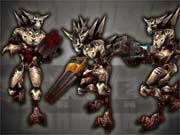
The PS2 makes the textures and environments in Quake III look better than they ever have. The game features updated versions of all the maps found in the PC version of the game, and it even has several exclusive new maps designed specifically for the PS2 version. All the PC maps have received a major face-lift. Some maps have been modified to appeal to a smaller number of players, but most of the maps have simply received a graphical overhaul. New textures and lighting effects make the castle and interior maps look a lot better, and new backgrounds and ambient details make the outdoor and space maps look simply incredible. Some of the best examples of the graphical enhancements to the maps in the Quake III Revolution are the effects added to CTF4, the capture the flag map set in space. The PC version of the map took place in the black void of space, but the PS2 version is set just outside the orbits of several amazingly beautiful planets-- it has solar gasses, and it even features an asteroid belt. These additions make the map look much better, and they really build upon the already impressive graphics of the PC version. Several of the mainstay PC character models have been tweaked and reinvented for the PS2 version, and all the characters have also been completely redrawn with greater texture detail. These characters not only look better when standing still, but they also look very nice in the game. The game runs at a silky smooth frame rate that never seems to slow down or get choppy. All the animations are fluid, and the game simply screams along. With improved character models, redone maps, and new graphical effects, Quake III has never looked better.
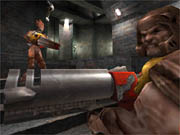
The audio elements in the PS2 version of Quake III are very similar to those of the PC version. The simplified techno-rock hybrids play over all the levels, with only a little deviation between songs. Bullfrog has added new voice effects to the game, and it has even re-recorded several of the phrases from the PC version. Unfortunately, the new voices aren't any better than the old voices, and some of the godlike phrases are laughable. New weapon sound effects and ambient noises help round out the game. But one of the best new uses of sound is a varied hit noise--now the noise you hear when you hit an enemy with a weapon is different depending on how much damage the hit incurred. So splash damage from a rocket will make a less dramatic hit noise than nailing someone with the railgun will. This effect really helps to gauge your performance, and it makes a big difference in a heated battle.
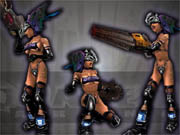
Bullfrog is trying to take the best elements from all of the Quake III add-ons, mods, and spin-offs and combine them in Quake III Revolution. As such, the game features plenty of elements from Quake III: Team Area. The three new weapons featured in the add-on pack are alive and well in Quake III Revolution--the proximity mine launcher, the chaingun, and the nailgun are all back for another round. Additionally, the game features the new power-up items found in the Quake III: Team Arena. The kamikaze and invisibility power-ups were already in the build we played, and it's likely that Bullfrog will add the ammo regen, doubler, scout, and guard items to the game. Bullfrog is also hard at work adding plenty of new player models to the game, and it's likely that models from other games in the Quake series and models from other Bullfrog games will make an appearance somewhere in the game.
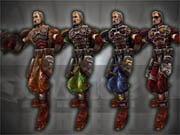
Quake III Revolution plays just as fast as the PC Quake III titles. The combat is fast and frenzied, and the action never seems to slow down. The controller has several different layouts, including control schemes that mimic those of games like X-Squad and Unreal Tournament on the PS2. Additionally, several configurable options, such as the analog sensitivity, help adjust the PS2 controller to suit any player. The game features all the same difficulty modes as the PC version, and it represents them exactly as the PC version did. Bots will often stop moving to shoot and rotate in the "I can win" setting, while the "nightmare" setting has bots pulling off amazingly acrobatic stunts and making nearly impossible shots with the railgun. And while we encountered no problems nailing bots when aiming on the horizontal axis, we did encounter some problems aiming on the vertical axis. The game offers a fairly forgiving auto-aim feature to help you lock on to enemy players, but even with the analog sensitivity turned all the way up, we found it was difficult to hit targets that were either higher or lower than you. This flaw could hurt the success of players deadly with the railgun, and it might even make more popular maps like CTF4, DM16, and DM17 less fun. Still, Bullfrog has some time to address this issue before the game releases. Additionally, while EA couldn't confirm USB keyboard and mouse support for the game, it's likely this feature will be included.
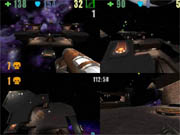
Fans of the Quake franchise will definitely be pleased with all the enhancements in Quake III Revolution, and those who've been waiting for a solid PS2 shooter should be happy when the reigning king of deathmatch hits the PS2. Lack of Internet support does make the PS2 version of Quake III a less interesting game than its DC and PC counterparts, but a well developed single-player mode, the classic four-player split-screen play, and all the extras added to the game help make up for it. Quake III Revolution hits store shelves on March 27.
Got a news tip or want to contact us directly? Email news@gamespot.com
Join the conversation